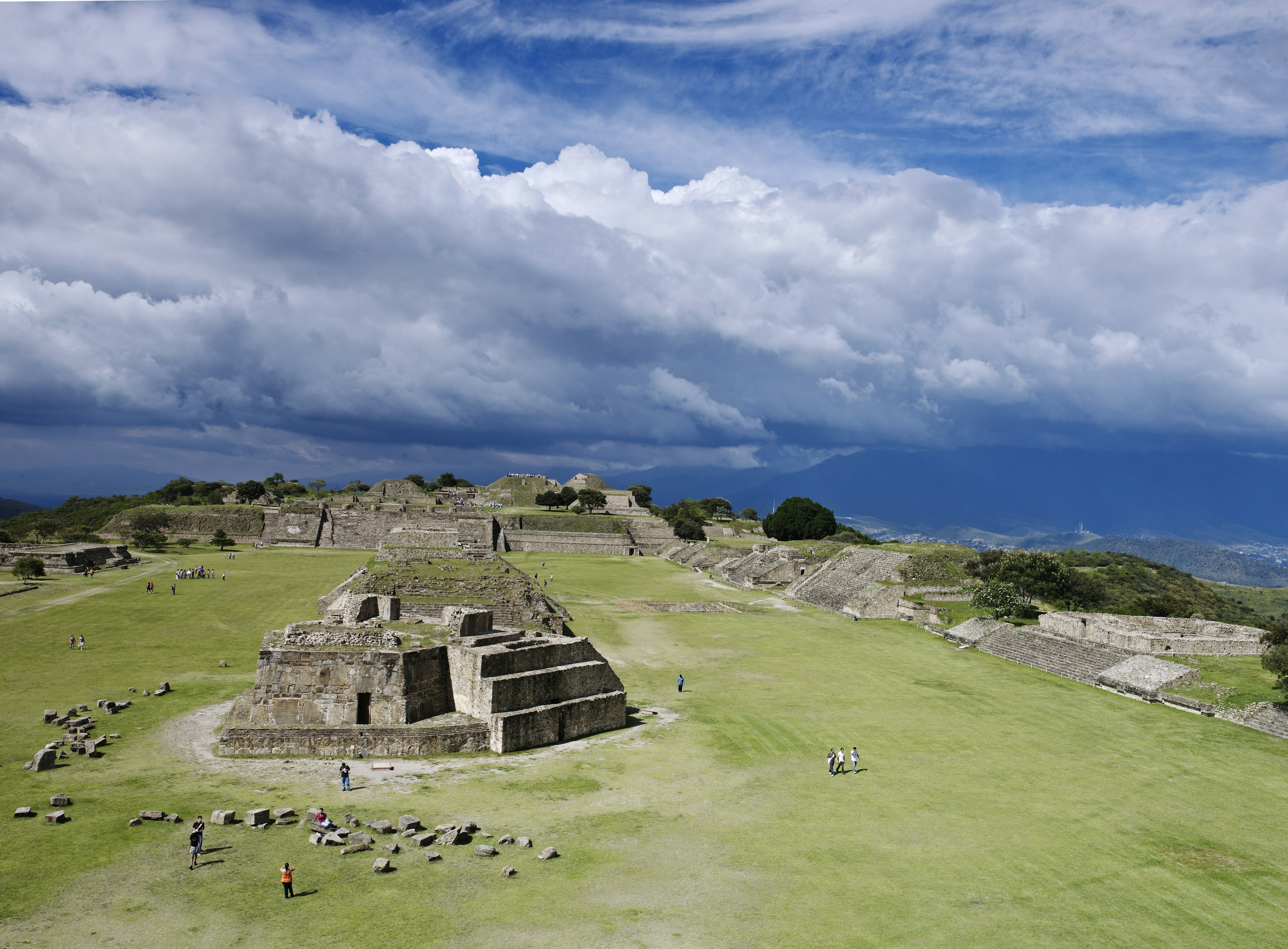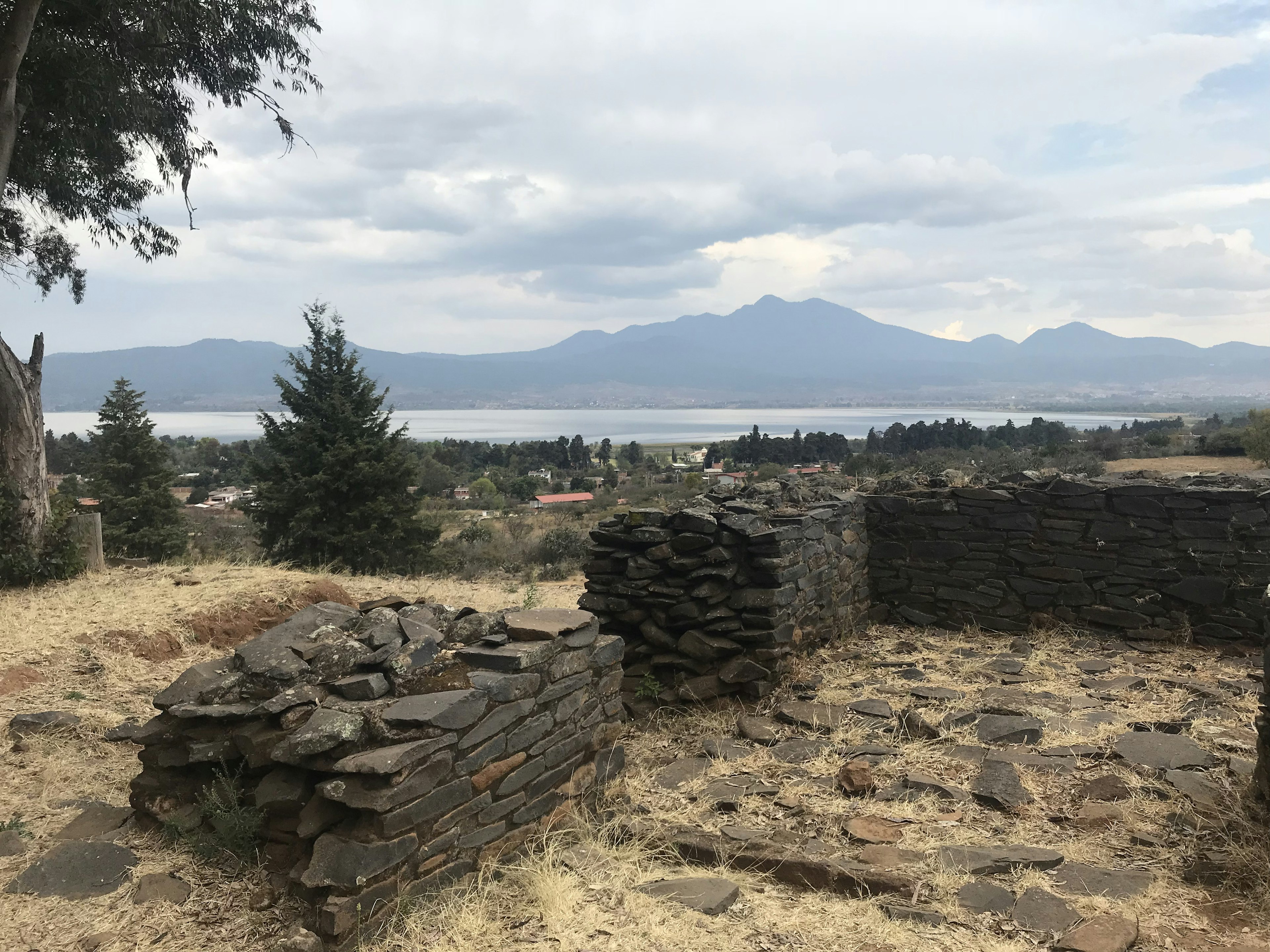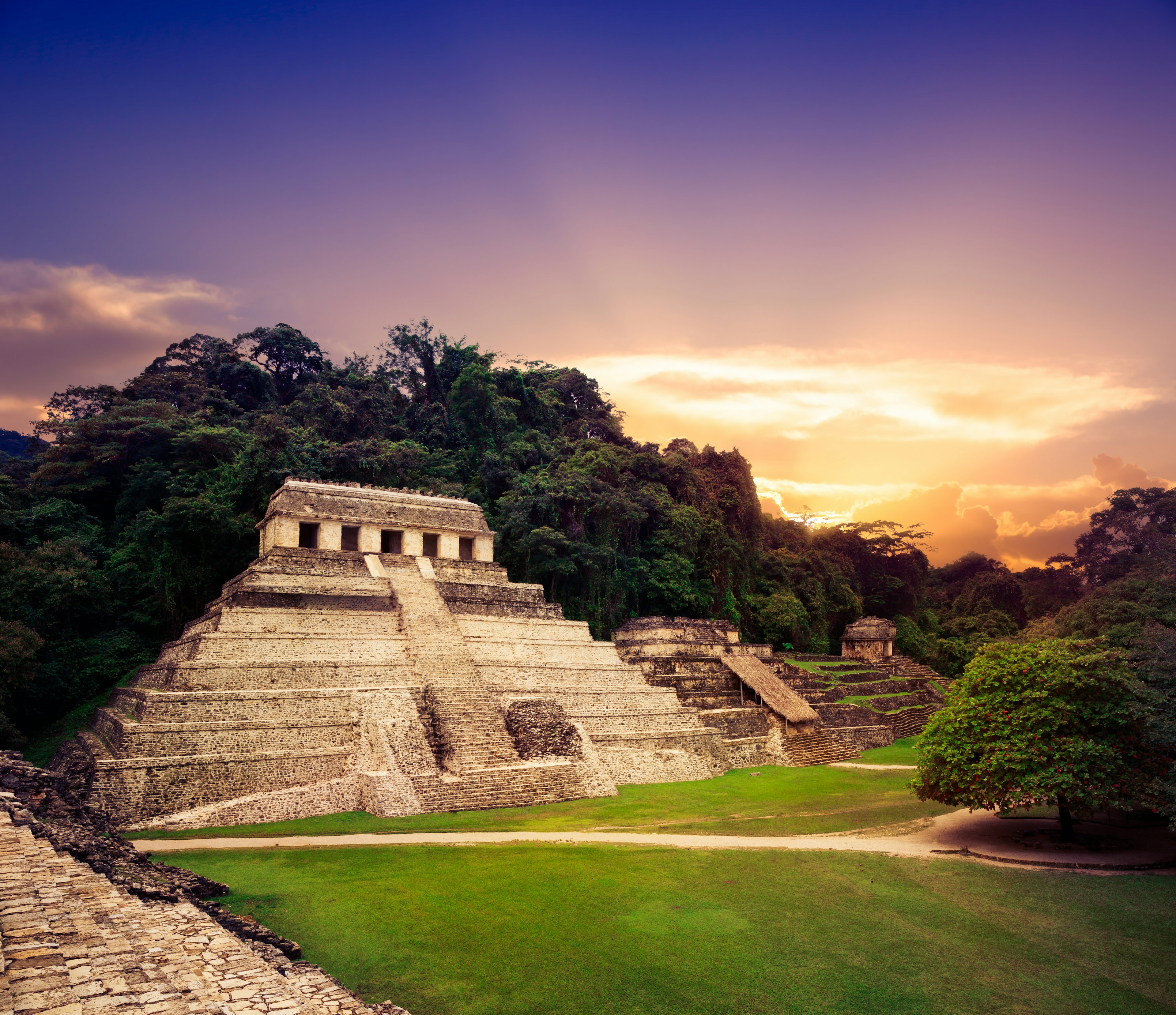Mexico’s ancient civilizations were the most sophisticated and formidable in North and Central America. These often highly organized societies didn’t just build towering pyramids and sculpt beautiful temples; they could also read the heavens, do complicated mathematics and invent writing systems.
Exploring their sites is an unmissable Mexico travel experience. Read on for tips on which ruins to visit in Mexico, when is the best time to visit and what to look out for.
1. Palenque
Ancient Palenque stands at the precise point where the first hills rise out of the Gulf coast plain, and the dense jungle covering these hills forms an evocative backdrop to Palenque’s exquisite Maya architecture. Hundreds of ruined buildings are spread over 15 sq km, but only a fairly compact central area has been excavated. Everything you see here was built without metal tools, pack animals or the wheel. As you explore the ruins, try to picture the gray stone edifices as they would have been at the peak of Palenque’s power: painted blood red with elaborate blue and yellow stucco details. The forest around these temples is still home to howler monkeys, toucans and ocelots.
Palenque sees more than 1000 visitors on an average day, and visitor numbers spike in the summer vacation season. Opening time is a good time to visit, when it’s cooler and not too crowded, and morning mist may still be wrapping the temples in a picturesque haze. The ruins are located in Parque Nacional Palenque, which has a M$35 entrance fee.

2. Teotihuacán
This complex of awesome pyramids is set amid what was once Mesoamerica’s greatest city. The sprawling Teotihuacán site is comparable to the ruins of the Yucatán and Chiapas for significance, and anyone lucky enough to come here will be inspired by the astonishing technological might of the Teotihuacán civilization. Set 50km northeast of Mexico City, in a mountain-ringed offshoot of the Valle de México, Teotihuacán is known for its two massive pyramids, Pirámide del Sol (Pyramid of the Sun) and Pirámide de la Luna (Pyramid of the Moon), which dominate the remains of the metropolis.
Pirámide del Sol is the world’s third-largest pyramid – surpassed in size only by Egypt’s Cheops (which is also a tomb, unlike the temples here) and the pyramid of Cholula – overshadows the east side of the Calzada de los Muertos. When Teotihuacán was at its height, the pyramid’s plaster was painted bright red, which must have been a radiant sight at sunset. Clamber (carefully by rope) up the pyramid’s 248 uneven steps – yes, we counted – for an inspiring overview of the ancient city.
Open 365 days a year, this site costs just M$80 a person to visit – less than $4 USD. This well-kept and restored site is easy to navigate and has a lot to see, making it a great choice for families, especially if you’re trying to see as much as possible in a short amount of time.

3. Chichén Itzá
The most-famous and best-restored of the Maya sites on the Yucatán Peninsula, Chichén Itzá, while tremendously crowded, will still impress even the most jaded visitor. Indeed, its inclusion in the New Seven Wonders of the World in 2007 came as no surprise at all. Many mysteries of the Maya astronomical calendar are made clear when one understands the design of the “time temples” here.
This site draws big crowds, especially during the summer months, with more than two million people visiting Chichén Itzá each year. One reason for this is that the site is easy to get around, and is even stroller-friendly if you don’t mind some bumpy spots.
The heat, humidity and crowds in Chichén Itzá can be fierce, as can competition between the craft sellers who line the paths. To avoid this, explore the site either early in the morning or late in the afternoon, or consider splashing out on a private tour allowing you access to the site before it officially opens at 8am.
Planning tip: The newly (and partially) launched Tren Maya, which currently runs from Cancún to Campeche, has a station at Chichén Itzá. The train, which has stirred some controversy, will connect archaeological sites across the Yucatán peninsula.
Getting to know Chichén Itzá, the heart of the Maya Empire in Mexico

4. Uxmal
Pronounced oosh-mahl, Uxmal’s size and uniqueness make it a fascinating stop for ruin-lovers and novices alike. The top draws are the oddly shaped Magician’s House, the Pigeon House (a structure with a delicate roof comb still standing that resembles pigeon houses) and the vast Governor’s Palace. Part of the Puuc region, it is an unmissable stop if you’re in the area. For an additional cost, Uxmal projects a nightly light-and-sound show.
Getting to Uxmal is a little more challenging than some of the other sites on this list, including Chichén Itzá. But that doesn’t mean that it doesn’t offer equally impressive ruins. Your best bet is to go by car or bus from the city of Merida. The ride takes about an hour.

5. Monte Albán
The city from which the ancient Zapotecs once ruled Oaxaca’s Valles Centrales, Monte Albán towers more than 400m above the valley floor from a hilltop a few miles west of Oaxaca. Monte Albán is one of Mexico’s most culturally rich archaeological sites, with the remains of temples, palaces, tall stepped platforms, an observatory and a ball court all arranged in orderly fashion, with wonderful 360-degree views over the city, valleys and distant mountains. Monte Albán traces its roots to 500 BC and its 1300-year history is usually split into five archaeological phases. The city reached its apex between AD 300 and 700, but was abandoned long before the Spanish arrived in the 1520s.
While busy compared to other Oaxaca archaeological sites, Monte Albán avoids the tour-bus circuit of some of the better-known ruins around Mexico City and Cancún.
This site has been a UNESCO World Heritage site since 1987. In 2008, it was recognized as a site to watch, as a number of threats have damaged and eroded the ancient ruins here, causing severe damage in recent years.

6. Tulum
The ruins of Tulum preside over a rugged coastline, a strip of brilliant beach and green-and-turquoise waters that’ll leave you floored. It’s true the extents and structures are of a modest scale and the late-post-Classic design is inferior to those of earlier, more grandiose projects – but, wow! Those Maya occupants must have felt pretty smug each sunrise. You can see (at a premium price) the sunrise yourself on a sunrise tour. Late-risers may prefer the sunset tour, though the sun sets over the jungle, not the sea.
Tulum is a prime destination for large tour groups. To best enjoy the ruins without feeling like part of the herd, you should visit them early in the morning, another benefit of the sunrise tour.
Tickets to visit cost M$80 per person, with guided tours available for M$700. Keep in mind that while you can get close to most of the structures here, the majority are closed to climbing.
7. Calakmul
Calakmul is a magnificent experience, made even better by its history as a leading city from around AD 250. Many buildings survive, evoking a sense of a powerful place, and getting there – its serious remoteness – makes it all the more special. But visiting Calakmul is not just a historical experience, it’s also an ecological one. Lying at the heart of the vast, untrammeled Reserva de la Biosfera Calakmul (which covers close to 15% of the state’s total territory), the ruins are surrounded by rainforest and a seemingly endless canopy of vegetation. You might glimpse ocellated turkeys, parrots, toucans and more – around 350 bird species reside or fly through here. You’ll no doubt see or hear spider and howler monkeys, too. You’re much less likely to spot a jaguar – one of five kinds of wildcat in the area – but it’s not impossible.

8. Tzintzuntzan
The site of Tzintzuntzan comprises an impressive group of five semicircular reconstructed temples known as yácatas, which are all that remain of the mighty Purépecha empire. The hillside location offers wonderful views of the town, lake and surrounding mountains and is rarely crowded. A small but well-curated museum showcases finds from the site, including jewelry and pottery. Don’t miss the replica of the Ihuatzio coyote. Down the hill to the east there are some boulders with carved petroglyphs of barely recognizable deities. A small info point and some flowering bushes highlight a project that’s trying to entice the once-abundant hummingbird back to the area; “Tzintzuntzan” means “place of the hummingbird” in Purépecha.

9. Edzná
Edzná’s massive complexes, which once covered more than 17 sq km, were built by a highly stratified society that flourished from about 600 BC to the 15th century AD. During that period, the people of Edzná built more than 20 complexes in a melange of architectural styles, installing an ingenious network of water-collection and irrigation systems. Edzná means “House of the Itzáes,” a reference to a predominant governing clan of Chontal Maya origin. Most of the visible carvings date from AD 550 to 810. The causes leading to Edzná’s decline and gradual abandonment remain a mystery; the site remained unknown until its rediscovery by farmers in 1906.
10. Templo Mayor
Located in the historic heart of Mexico City is Tenochtitlan, the former capital of the Aztec Empire. In the center of their new capital, the Aztecs built Templo Mayor, or Main Temple. It stretched 60m into the sky and featured two step pyramids atop a large platform. Each tower was dedicated to a different god – one to Tlaloc and one to Huitzilopochtli. It would have towered over the ancient city and was meant to represent two sacred mountains. Like many Aztec ruins, it was destroyed and built over by Spanish settlers. But in 1978, electrical workers discovered a stone disc weighing eight tons. The colonial buildings built over the pyramids were removed, and the temple was excavated.
Visitors can walk up and view the ruins at any time of day. However, it’s best to visit the on-site Templo Mayor Museum to learn more about the Aztec culture.
11. Cobá Ruins
Despite often being overlooked among the many other famous ruins located throughout Mexico, archaeologists believe that the Cobá Ruins were one of the most important sites on the Yucatan Peninsula. While the site of this ancient Mayan city was discovered in the 1800s, its location in a dense jungle, as well as wars in the area, means that it is still largely unexcavated. Experts believe that the area may have more than 6,000 structures, but so far only three settlements have been opened to the public.
Today, you can climb Nohoch Mul, the largest Mayan pyramid in the Yucatan, and see two ball courts. The top offers great views of the surrounding jungle. You can also take a stroll along sacbés. These ancient roads are built from limestone, and once connected the Coba Ruins to other Mayan cities.
12. El Tajín
If you find yourself in Veracruz, Mexico, you’ll definitely want to make a side trip to Papantla. Just outside of this small town, you’ll find the ancient ruins of El Tajín. Translating to “thunder” in the Toltex language, these ruins include a large complex with a ceremonial center. The settlement saw its heyday sometime between 800 and 1200 AD. It’s believed that the civilization wasn’t built by the Mayans, but instead by a related tribe.
Around 150 structures have been identified so far, and around 20 have been excavated and restored, and are available to visit. One of the city’s highlights is the Pirámide de los Nichos. The name comes from the 365 small niches formed from stone blocks on the pyramid. Each is painted red on the inside and blue on the frames. For this reason, archaeologists believe that the pyramid was used to measure time.
Another site to see in El Tajín is the Plaza Menor, which was possibly a marketplace and still has remaining traces of red and blue paint.
13. Guachimontones Archaeological Site
Perhaps the most unusual site on this list is the Guachimontones Archaeological Site. This site is best known for its round step pyramids. These structures feature almost perfectly circular layers stacked atop each other, reaching up to 18m high. It’s believed that these pyramids had a volador pole at the top that dancers would jump from to appease the gods.
Ten of these structures have been discovered, and three have been excavated and opened for viewing. Unlike some of Mexico’s ancient pyramids, these are not open to climb. There are also two ball courts, two long plazas, and several other structures on-site that visitors can see. Make sure to stop by the site’s circular museum, where you can learn about the ruins and the people who built them and even check out artifacts discovered on the site.
14. Becán
While the ancient Mayan name of this site has been lost to time, the archaeologists who rediscovered it in 1934 chose the name Becán because it means “ravine formed by water.” The moat that surrounded the site created a massive barrier and likely provided defense for the civilization.
While the site is still largely unexcavated, around 20 structures across three different sites are open for viewing. Seven different access points to cross the moat have been discovered. The largest is the pyramid located in the settlement Central Plaza. It rises around 100 feet tall, and can be climbed with the help of a knotted rope.
You might also like:
Mexico has 11 beautiful new “magical towns” to explore
Where to find cenotes, Mexico’s amazing natural swimming holes
Mexico’s family-friendly destinations to explore with kids
